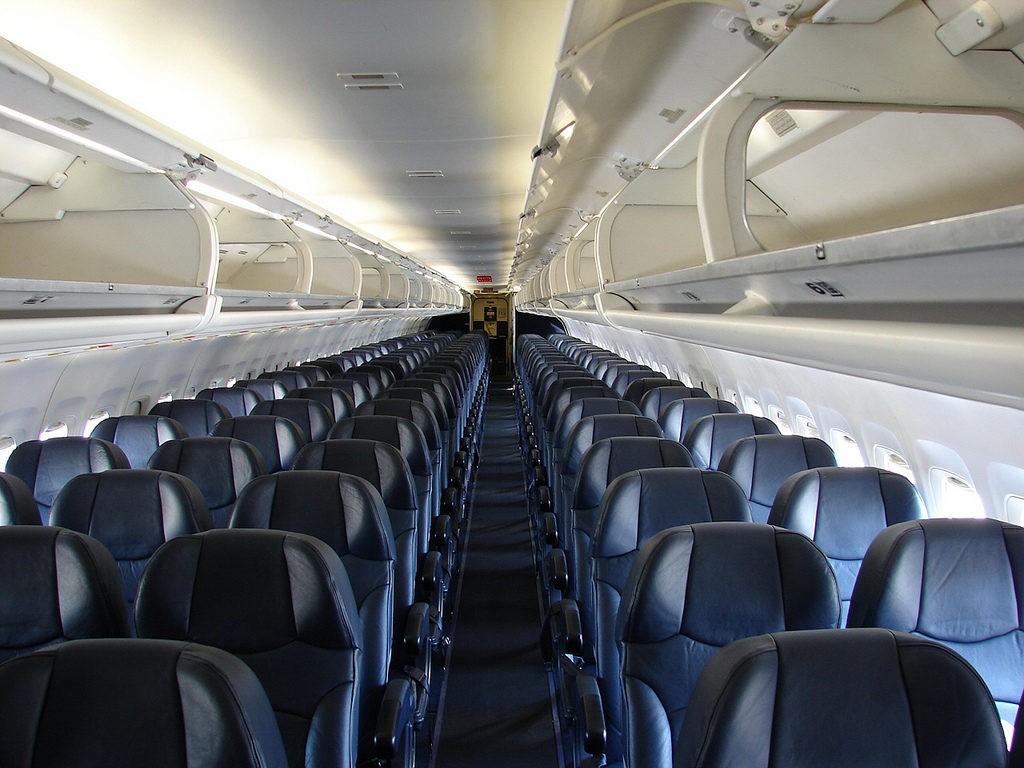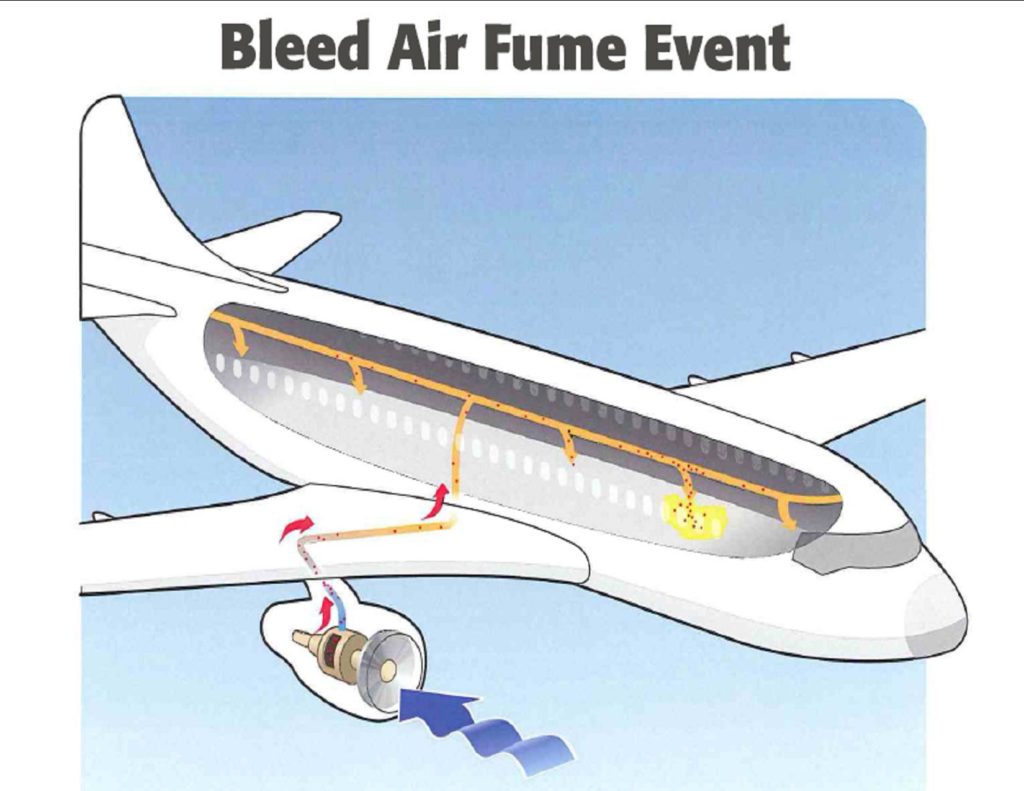
While aviation is a highly-regulated and risk averse industry, the issue regarding air supplied to aircraft cabins is worthy of review, as aviation health consultant, Dr Susan Michaelis, explains.
Modern aircraft, except for the Boeing 787 Dreamliner, draw the aircraft air supply unfiltered from the engines. This design, using engine ‘bleed air’, was regarded as more cost effective, despite early awareness that the air could become contaminated by engine oil leaking into the air supply.
The use of an bleed air system, by design, allows low-levels of synthetic engine oil leakage to enter the bleed air and cabin air supply.[[i]] The aviation industry focuses on the occasional higher level oil seal or mechanical failure conditions, ignoring the lower-level oil leakage occurring in normal flight. No contaminated air detection systems are fitted to aircraft. The oils and other fluids contain a range of hazardous substances including organophosphates (OPs) and a wide range of pyrolysis substances.

Occupational disease
There is increasing literature supporting that exposure to the bleed air contaminants are associated with a diverse range of short and long-term adverse effects. Neurological, neurobhavioural, respiratory, irritant effects amongst others have recently been reported in a World Health Organization journal paper identifying ‘Aerotoxic Syndrome’ as a new occupational disease. [[ii]]
Additionally, many organizations recognise the flight safety implications related to contaminated air including the International Civil Aviation organization (ICAO), the International Federation of Airline Pilots (IFALPA), and the UK Air Accidents Investigation Branch (AAIB). The AAIB has twice recommended for the European Aviation Safety Agency (EASA) to mandate contaminated air detection systems in all aircraft, yet this has not been implemented.
The aviation industry, along with governments, have continued to suggest there is no concern regarding the aircraft contaminated air issue. Studies surrounding leaking oils and contaminated bleed air commenced with US military studies in the early 1950s, which identified the oils became more toxic with increased temperatures.
Recent studies
The number of studies, inquiries, standards, bills and reviews has greatly increased internationally in the last two decades. The most recent studies undertaken by EASA have recognized oil leakage in normal flight, but have suggested levels are too low to be of concern, with other factors suggested to be the cause of adverse effects continuing to be reported globally.
There is extensive supporting evidence that occupational Exposure Limits should not be applied to the aircraft environment, that the bleed air design does not meet the aviation regulatory requirements [1] and that the studies are critically flawed and not independent. There are an increasing range of scientific studies that address low-level repeat exposures to OPs and complex mixtures.
Aircraft air supplies contaminated by pyrolysed engine oils and other aircraft fluids are suggested to be reasonably linked to adverse effects, medical findings and diagnoses, thus establishing causation. [2]
Elsewhere non-bleed air new technology has been trialled in Europe, but is yet to be adopted by the manufacturers. Bleed air filtration is currently being trialled and a new bill has been submitted to the US Congress to address air supply safety improvements. There have also been a several legal cases undertaken. While most have been settled [[iii]], in 2010 the High Court of Australia, found that Mobil Jet Oil II harms the lungs.
Very often globally there is an arrangement or a memorandum of understanding between the aviation and health and safety regulators, giving the aviation regulator priority over the aircraft environment. However it is acknowledged the aviation regulators do not have the expertise related to hazardous substances, while the OHS regulators are effectively kept out of the cabin environment and the applicable regulations and directives are not applied in practice.
The aircraft contaminated air issue is an example of repeated and not infrequent impairment and incidents, rather than the occasional accident and fatal injury. It requires expert attention and the available solutions to be enacted. Additionally if a fatal accident had occurred, it would be unlikely to be detected, as there are no contaminated air warning systems, despite regulatory requirement.
On 19-20 September 2017, the largest international cabin air quality conference ever held will take place at Imperial College in London. Dr Susan Michaelis will speak and solutions will be discussed. [[iv]]
Contact Susan Michaelis at: [email protected]
References
[i]. Michaelis S. Implementation Of The Requirements For The Provision Of Clean Air In Crew And Passenger Compartments Using The Aircraft Bleed Air System. Cranfield University: http://www.susanmichaelis.com/caq.html (2016).
[ii]. Michaelis S, Burdon J, Howard C. Aerotoxic Syndrome : a New Occupational Disease ? Public Health Panorama (WHO). 2017;3(2):198–211. http://www.euro.who.int/en/publications/public-health-panorama/journal-issues/volume-3,-issue-2,-june-2017
[iii]. Blomberg (2017) Airsick: Flight Crews Venting in Court About Toxic Fumes: https://www.bna.com/airsick-flight-crews-n73014461012/
[iv]. International Cabin Air Conference. 19-20 September, London: https://www.aircraftcabinair.com/
What makes us susceptible to burnout?
In this episode of the Safety & Health Podcast, ‘Burnout, stress and being human’, Heather Beach is joined by Stacy Thomson to discuss burnout, perfectionism and how to deal with burnout as an individual, as management and as an organisation.
We provide an insight on how to tackle burnout and why mental health is such a taboo subject, particularly in the workplace.




A very interesting subject, one I am not familiar with but can associate to the many times I have experienced the all to familiar smell Av Gas in the cabin during flight. I had often wondered about the ventilation and circulator systems for air and often recognised poor air quality. In construction, if we were providing poor air quality in a forced ventilation scenario, which is not dissimilar to air supply in a cabin, prosecution would be inevitable